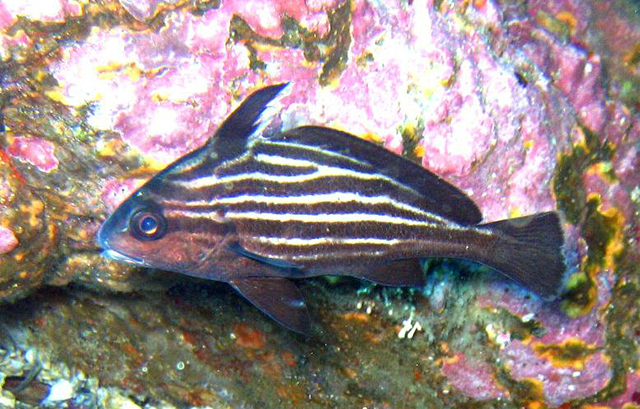
|
Pareques lineatus (Cuvier, 1830) |

|
|
photo by
Carvalho Filho, A. |
| Family: | Sciaenidae (Drums or croakers) | |||
| Max. size: | 16.1 cm SL (male/unsexed) | |||
| Environment: | reef-associated; marine; depth range 1 - 100 m | |||
| Distribution: | Western Atlantic: Puerto Rico to Brazil, through the Lesser Antilles in the Caribbean. | |||
| Diagnosis: | Dorsal spines (total): 10-10; Dorsal soft rays (total): 37-40; Anal spines: 2-2; Anal soft rays: 7-7. This species is distinguished from its congeners by the following characters: lateral-line scales 50-55; scales from lateral line to origin of dorsal fin 8-9 and from lateral line to first anal fin spine 9-10; chin with 5 pores. Colouration: adults brownish with 5-7 longitudinal, irregular white stripes thinner than dark ones and by without submarginal white stripe on soft dorsal fin; no dark bar between eyes in adults and without the wide, transverse dark bar from dorsal-fin origin almost to pelvic-fin base (Ref. 128874). | |||
| Biology: | Occurs in rocky and coral reefs from one to about 100 meters deep, and usually between three and 30 meters. Juveniles of about the same age, often in groups of 3-7, were observed in very shallow water under ledges or near sand pockets close to reef crevices, The young are usually found in small groups of up to three individuals in 5-20 m, while adults are in groups of three to at least 25 individuals, among rocks, under ledges, inside caves and, at daylight, in the water column, mixing schools with fishes of similar size, such as haemulids. The species is mainly nocturnal, spending the day sheltered and feeding at night on sand, grass beds, mud, and rubble bottoms close to the reef, feeding on crustaceans, polychaetes, small bony fishes, zooplankton, and algae. In Aracaju, Sergipe, Brazil, a group of about 20 adults was observed cleaning and picking mucus or parasites off a large stingray, Hypanus berthalutzae, that stayed quietly at the bottom (Ref. 128874). | |||
| IUCN Red List Status: | Not Evaluated (N.E.) Ref. (130435) | |||
| Threat to humans: | harmless | |||